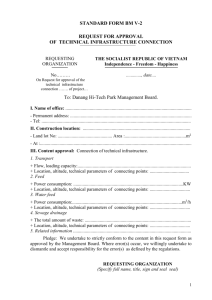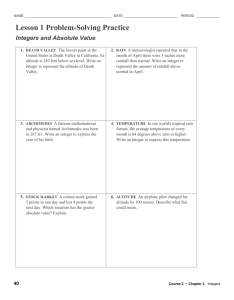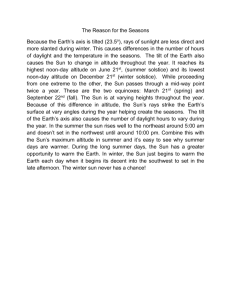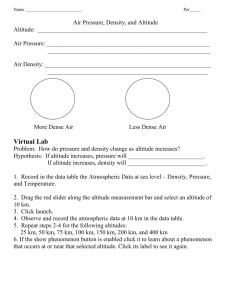Definitions of Altitude
advertisement
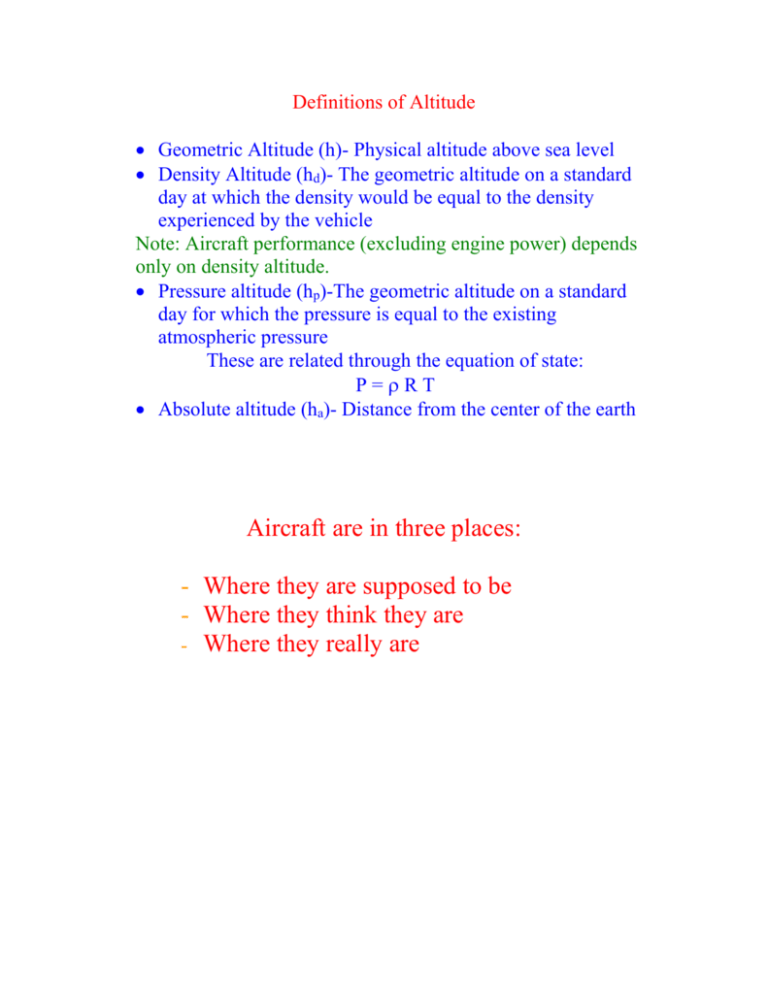
Definitions of Altitude Geometric Altitude (h)- Physical altitude above sea level Density Altitude (hd)- The geometric altitude on a standard day at which the density would be equal to the density experienced by the vehicle Note: Aircraft performance (excluding engine power) depends only on density altitude. Pressure altitude (hp)-The geometric altitude on a standard day for which the pressure is equal to the existing atmospheric pressure These are related through the equation of state: P=RT Absolute altitude (ha)- Distance from the center of the earth Aircraft are in three places: - Where they are supposed to be - Where they think they are - Where they really are The Atmosphere The challenge is to define the atmospheric properties as a function of height so that this information will be readily available analytically to guide both aircraft design and operations The equation of state of a perfect gas is: P = RT Where: P = pressure in Newtons/square meter or Lb/square foot = density in Kg/M3 or Slugs/Ft3 T = Absolute temperature in degrees Kelvin (K) or degrees Rankine ( R ) R = gas constant(287.05 n-m/kg K) (1718 ft-lb/slug R) for air Also important is the hydrostatic equation: dP = -gdh where: g = the gravitational constant = 9.8 m/sec2 or 32.17 ft/sec2 at sea level h = the altitude above sea level dP = -gdh Divide the hydrostatic equation by the equation of state dP/P = -gdh/RT = -(g/RT)dh First consider the isothermal region of the atmosphere: h dP / P = -(g/RT) dh P P1 h1 ln P/P1 = -(g/RT)(h-h1) P/P1 = e-(g/RT)(h-h1) Relate pressure and density through the equation of state: P/P1 = T/1T1 Since the region is isothermal T = T1 P/P1 = /1 and /1 = e-(g/RT)(h-h1) Now consider the case of gradient layers in which the temperature varies linearly with height Thus T = T1 + a(h – h1), where a = dT/dh T and h are the temperature and altitude at some point in the gradient layer and T and h are the values at some higher altitude point a is called the lapse rate dh = 1/a(dT) Substituting for dh in dP/P = -gdh/RT gives dP/P = -(g/aR)dT/T P T P1 T1 dP / P g /( aR) dT / T ln P/P1 = -(g/aR)ln T/T1 Thus P/P1 = (T/T1) -(g/aR) From the equation of state: P/P1 = (T/T1)(/1) And T/1T1 = (T/T1) -(g/aR) Or /1 = (T/T1) -(g/aR+1) Key Atmospheric Parameters Lapse Rate a =-.0065 K per meter = -.00356 R per foot At Sea Level Ps = 1.01325 x 105 N/m2 = 2116.2 lb/ft2 s = 1.225 kg/m3 = .002377 slug/ft3 Ts = 288.16 K = 518.69 R Summary From the surface to the isothermal region; For Temperature use: T = T1 + a(h – h1) For Pressure use: P/P1 = (T/T1) -(g/aR) For Density use: /1 = (T/T1) -(g/aR+1) Above 11,019 meters in the isothermal region Temperature constant at 216.66 K to 25.1 Km For Pressure use: P/P1 = e-(g/RT)(h-h1) For Density use: /1 = e-(g/RT)(h-h1) Isothermal Region P/P1 = e-(g/RT)(h-h1) /1 = e-(g/RT)(h-h1) Temperature constant at 216.66 K to 25.1 Km ~ 11 Km Gradient Region T = T1 + a(h – h1) P/P1 = (T/T1) -(g/aR) /1 = (T/T1) -(g/aR+1)



